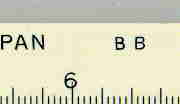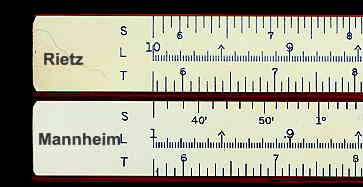Early Hemmi trademark. The "J' was officially
dropped in 1928.
|

|
Trademark 1928 - 1946. The company name
was officially changed from "J. Hemmi and Co" to "Hemmi Seisakusho &
Co." (Hemmi Engineering Works Co.) in 1928 but company was referred to
as "Hemmi Seisakusho" at least as early as 1917. Hemmi was incorporated
as a public corporation in 1933 with no change in name.
|

|
MIOJ 1947 - 1949. The Allied Powers occupation
of Japan lasted from August 1945 until April 28, 1952 but the requirement
that export goods be marked "Made in Occupied Japan" was in effect only
from 20 February 1947 to 5 December 1949. (Thanks to Wataru Tsuchihira
who found the original orders in the Japanese National Library.)
|

|
Trademark 1950 - 52. No quotes around
SUN.
|

|
Extra fine divisions on measuring scale 1937?
- 40? The first inch or first five centimeters of the measuring
scales on the bottom edge of ten-inch closed-body rules is extra-finely
divided. Although discontinued about WWII on ten inch rules; a short
section of extra fine divisions continued until the end of production on
models 86K and 86/3K.
|

|
Date codes 1951-1975. There is a small
date code in the form “YM” engraved into each slide rule but often not
colored. That can make it difficult to find. Often it is in
the lower left of the rear of the rule but can appear almost anywhere.
It sometimes takes inspection with a magnifier in raking light to find
the date code.
First letter of the date code indicates the year of manufacture with
A = 1950. Second letter indicates month with A = January. Thus
“BB” indicates February 1951. All-plastic rules use the same date
codes preceded by “ヘ” so that the date code looks like “ヘYM.”
“A” date codes are rare; I know of only two rules so marked.
(Both are model 86/3K rules marked "AL" (Dec 1950)). Most rules from
1950-52 escaped dating. The latest date code I'm aware of is "ZB"
(Feb 1975) on a Hemmi 254WN owned by Warren Salomon.
Date codes reveal the date of most post-1950 Hemmi slide rules but
it is not absolutely reliable. Some Hemmi slide rules that clearly
should have date codes, don’t. A very few have two different date
code. |

|
Rietz and Mannheim sine scales: There
are two common ways to lay out the S, sine, scale on closed-body rules:
In the "Rietz" layout, the S scale runs from 5o40' to 90o
and is keyed to the C and D scales on the face of the rule. In the
"Mannheim" layout the S scale runs from 0o34' to 90o
and is keyed to the A and B scales.
Rather perversely, from WWII until 1955 Hemmi "Mannheim" slide
rule models 30, 32, 34R, 34RK, 50 and 50W had "Rietz" (not "Mannheim")
S scales. Note the S scale on the upper slide from a Hemmi 50W
slide rule dated September 1952.
Before WWII and after 1955 Hemmi "Mannheim" rules had "Mannheim"
S scales. The lower slide is from a 50W dated May 1965.
|

|
Scale Labels and Over-Range Extensions:
Top picture: Early Hemmi closed-body rules had neither scale
labels no over-range extensions. (The rule shown is a Hemmi model
60/1, estimated date 1927.)
Middle picture. Over-range extensions, but not scale labels,
were gradually introduced. (The rule shown is a Hemmi model 60/1,
estimated date 1935).
Bottom picture: Scale labels and over-range extensions
became standard about WWII. (The rule shown is a Hemmi model 64T
with a date code for June 1968.)
|
 Click on image to enlarge.
Click on image to enlarge.
|
Extra Thick End Brackets on Duplex
Slide Rules:
In the 1960s Hemmi increased the thickness of the metal end brackets on
their duplex bamboo rules so that the rules would lie flat on a table with
the cursor suspended slightly above the table surface. The extra thickness
is not apparent to the naked eye and I have not been able to produce a
photograph that clearly shows the difference but it is readily apparent when
you place a duplex bamboo rule on a flat surface; newer rules lie flat with
both end brackets on the surface; older rules rock back and forth pivoting
on the cursor. Like many Hemmi features, the exact date of implementation
of this feature is hard to pin down. No literature mentions it.
All my 1.75-inch-wide bamboo Hemmi rules with date codes "O" (1964) or later
have thick brackets; all those with date codes "M" (1962) or earlier have
thin brackets.
The earliest 1.625-inch-wide bamboo rule I have with the thicker brackets
is a model 250 from 1960 (Date code "K.") --about three years earlier
than for 1.75-inch rules.
Thick brackets require slightly longer body screws.
|

